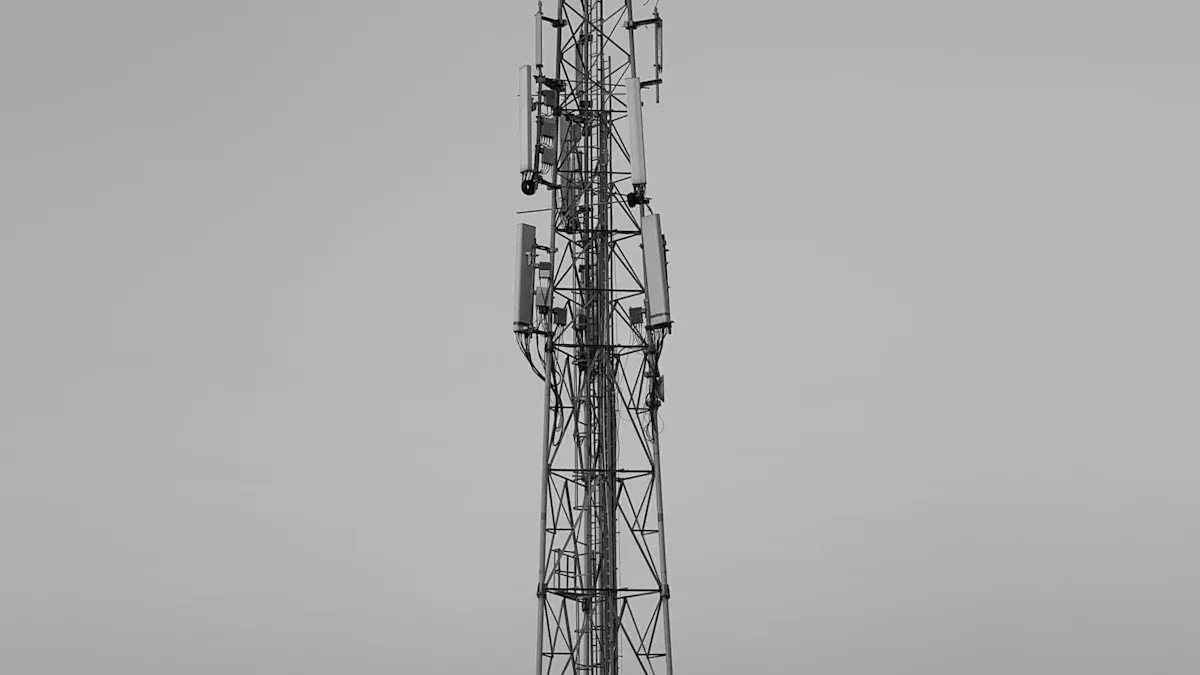Why Telecom Systems Depend on Enclosures with Rectifiers

Telecom systems rely on telecom enclosure rectifiers to maintain steady power. These components safeguard equipment and ensure smooth communication operations. With the expansion of 5G and IoT networks, power demands are rising significantly. As a result, the telecom power market is experiencing rapid growth, projected to increase from $4.76 billion in 2024 to $7.68 billion by 2029. Telecom enclosure rectifiers play a crucial role in delivering reliable service and supporting emerging advanced technologies.
Key Takeaways
Telecom enclosures keep equipment safe from dust, water, and heat. This helps the equipment last longer and work better.
Rectifiers change AC power into DC power. This is needed for telecom devices to work properly and smoothly.
New rectifiers have smart features. These save energy and prevent system failures, making telecom systems more dependable.
As networks expand, modular rectifiers make upgrades simple. They handle the growing power needs of 5G and IoT technologies.
Strong enclosures and rectifiers help telecom systems survive tough conditions. They ensure communication services stay reliable.
Understanding Telecom Enclosures and Rectifiers

What Are Telecom Enclosures?
Telecom enclosures are strong boxes that protect telecom equipment. They keep important parts safe from dust, water, and heat. These enclosures also stop people from damaging or tampering with the equipment.
To work well, enclosures must follow certain rules. For example:
NEMA and IP ratings show how well they block dust and water. Higher ratings mean better protection.
Tough materials like stainless steel or aluminum last in bad weather.
Good designs, like separate battery spaces and vents, stop overheating and rust.
These enclosures help telecom systems last longer and work better.
The Role of Rectifiers in Telecom Systems
Rectifiers are key parts of telecom power systems. They change alternating current (AC) from the grid into direct current (DC). DC is the type of power telecom devices need to run smoothly.
Rectifiers also charge backup batteries. This keeps power on during blackouts. Because they are reliable, rectifiers are very important for modern telecom systems. DC power systems, including rectifiers, are growing fast. They support new tech like 5G and IoT.
How Telecom Enclosures and Rectifiers Work Together
Enclosures and rectifiers work as a team to protect and power telecom systems. Enclosures keep equipment safe, while rectifiers provide steady power. Together, they make telecom networks strong and reliable.
For instance, DC systems save energy by skipping extra power changes. Studies show 400 V DC systems improve efficiency in telecom setups. Big companies like Google use 400 V DC racks for AI and machine learning. This shows how enclosures and rectifiers together boost system performance and dependability.
Benefits of Telecom Enclosure Rectifiers
Reliable Power Conversion and Regulation
Telecom rectifiers give steady power to telecom systems. They change alternating current (AC) into direct current (DC). DC power is needed for telecom devices to work well. This process reduces power changes, keeping devices running smoothly.
Modern rectifiers have advanced features that improve their use. For example:
Feature/Benefit | Description |
|---|---|
High power density | Fits more power in less space, saving room. |
High efficiency | Works at 92% efficiency, cutting energy costs. |
Low THD | Reduces power noise for better quality. |
Wide AC input range | Handles up to 480 Vac, making it flexible. |
Quick setup | Easy to install with automatic connections. |
Extended service life | Shares load evenly, making rectifiers last longer. |
Fail-safe performance | Protects equipment with safety features. |
Simplified control/monitoring | Easy to check and manage with digital tools. |
These features make rectifiers important for steady power. They help avoid problems and keep systems working well.
Protection Against Environmental and Electrical Risks
Telecom rectifiers protect equipment from weather and electrical dangers. They block dust, water, and heat, keeping parts safe. Their strong build resists rust, making them good for outdoor use.
Electrical problems like surges can harm systems. Rectifiers have safety features to stop damage. They detect and fix issues early with smart monitoring. This keeps equipment safe and running without breaks.
By guarding against weather and electrical risks, rectifiers make telecom systems stronger. They ensure systems work even in tough conditions.
Improved Efficiency and Reduced Downtime
Efficiency and uptime are key for telecom networks. Rectifiers save energy during power changes, cutting costs. With 92% efficiency, they perform well and save money. Their modular design allows easy upgrades as networks grow.
Rectifiers also reduce downtime. Maintenance-free batteries and modular systems keep them running. Smart tools find problems early, avoiding big issues. This keeps services reliable and costs low.
By boosting efficiency and uptime, rectifiers improve telecom systems. They meet modern network needs while staying reliable and cost-effective.
Role in Modern Communication Systems

Helping Technologies Like 5G and IoT
Telecom enclosure rectifiers are key for powering 5G and IoT. These systems need steady energy to work properly. Rectifiers change power and keep it stable, so devices stay connected.
Outdoor rectifier cabinets are becoming more popular. They manage power well, which is important for 5G setups. These cabinets also use smart tools to support IoT. They monitor power use in real-time, ensuring reliable service even during busy times.
By helping these technologies, rectifiers improve speed, reduce delays, and connect devices better. This makes them essential for modern telecom systems.
Growing with Expanding Networks
As networks grow, scalability becomes very important. Telecom rectifiers handle more power without losing efficiency. Their modular design makes upgrades easy, supporting bigger 5G networks and data centers.
Feature | Importance |
|---|---|
High Power Capacity | Three-phase rectifiers manage large power loads for growing networks. |
Growth Drivers | Expanding 5G and data centers need strong power solutions. |
Stable and Efficient | Rectifiers provide steady power, vital for modern communication systems. |
These features keep telecom systems flexible and reliable as networks expand. Rectifiers make it easier to meet growing demands while staying efficient.
Making Communication Services Reliable
Reliability is crucial for communication systems. Rectifiers give steady power to important services. They protect equipment from power problems and bad weather, keeping systems working.
Modern rectifiers have smart tools to find issues early. Fixing problems quickly prevents service interruptions. This keeps systems running smoothly with less downtime.
In emergencies, rectifiers provide backup power for critical services. They support things like healthcare and emergency response systems. Their strong design and safety features make them vital for dependable telecom networks.
Solving Challenges in Telecom Infrastructure
Handling Power Problems and Outages
Power issues can stop telecom systems from working. Outdoor cabinets with advanced rectifiers fix this. Rectifiers change AC to DC and keep voltage steady. This gives telecom systems stable power, even if the grid is unstable.
Backup batteries in modular enclosures add more reliability. These batteries turn on right away during outages, avoiding downtime. Modern rectifiers also have smart tools to find and fix power problems early. These solutions help keep communication services running without breaks.
Protecting Against Weather and Damage
Telecom systems face tough weather like storms, dust, and heat. Outdoor cabinets with weatherproof designs keep equipment safe. Strong materials and seals block water and dust. Cooling systems stop equipment from overheating.
Damage from vandalism or accidents can also hurt systems. Using strong enclosures with locks can prevent this. Modular designs make repairs and upgrades easy, reducing replacements. These steps keep telecom systems working in bad conditions.
Meeting High-Density Network Needs
5G networks need strong power systems. Old rectifiers with 48V DC can't handle this. New Class 4 rectifiers work with higher power and voltages. They also cut cabling costs, making them affordable for growing networks.
Outdoor cabinets with Class 4 rectifiers are flexible and scalable. They grow with network needs while staying efficient. Built-in cooling systems keep them working under heavy use. These solutions support 5G networks and save energy at the same time.
Telecom enclosures with rectifiers are key for communication systems. They keep networks strong, efficient, and ready to grow. These systems guard equipment, manage power, and help new tech like 5G and IoT.
Using good rectifiers makes your system stronger for the future.
Picking strong solutions helps avoid breaks and meet network demands.
FAQ
What do telecom enclosures do?
Telecom enclosures keep equipment safe from dust, water, and heat. They also stop people from tampering with the equipment. These cabinets help systems last longer and work better in tough places.
Why are rectifiers important for telecom systems?
Rectifiers change AC power into DC, which devices need. They also charge backup batteries to keep power on during outages. Rectifiers make systems more efficient and reliable.
How do cooling and ventilation help telecom cabinets?
Cooling and ventilation stop cabinets from getting too hot. Fans or air conditioners keep temperatures steady. Good airflow prevents equipment from breaking down.
Why are modular designs useful for growing networks?
Modular designs let systems grow as networks expand. You can add or upgrade parts without replacing everything. This helps support new tech like 5G.
How do telecom systems work in bad conditions?
Strong cabinets with weatherproof designs protect equipment. Cooling systems and rectifiers handle power changes. This keeps systems running well in tough environments.
See Also
Ensuring Consistent Power Supply for Telecom Equipment
Understanding -48VDC Usage and Grounding in Telecom Cabinets
Calculating Power Systems and Battery Needs for Telecom Cabinets
Key Features to Consider in Telecom Power Supplies
Integrating Solar Inverters and Batteries in Telecom Cabinets
CALL US DIRECTLY
86-13752765943
3A-8, SHUIWAN 1979 SQUARE (PHASE II), NO.111, TAIZI ROAD,SHUIWAN COMMUNITY, ZHAOSHANG STREET, NANSHAN DISTRICT, SHENZHEN, GUANGDONG, CHINA

